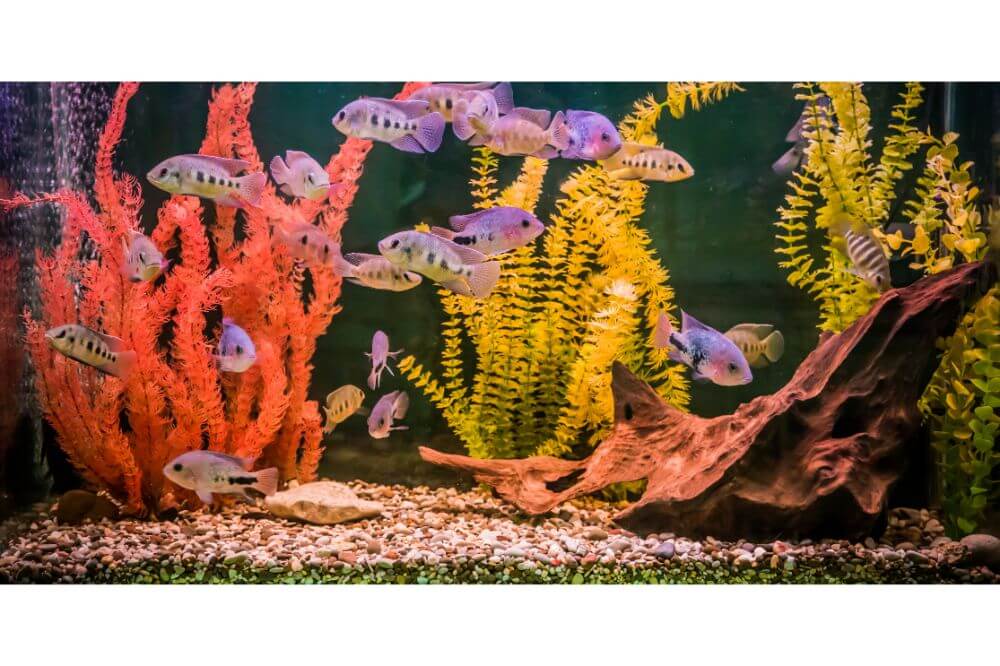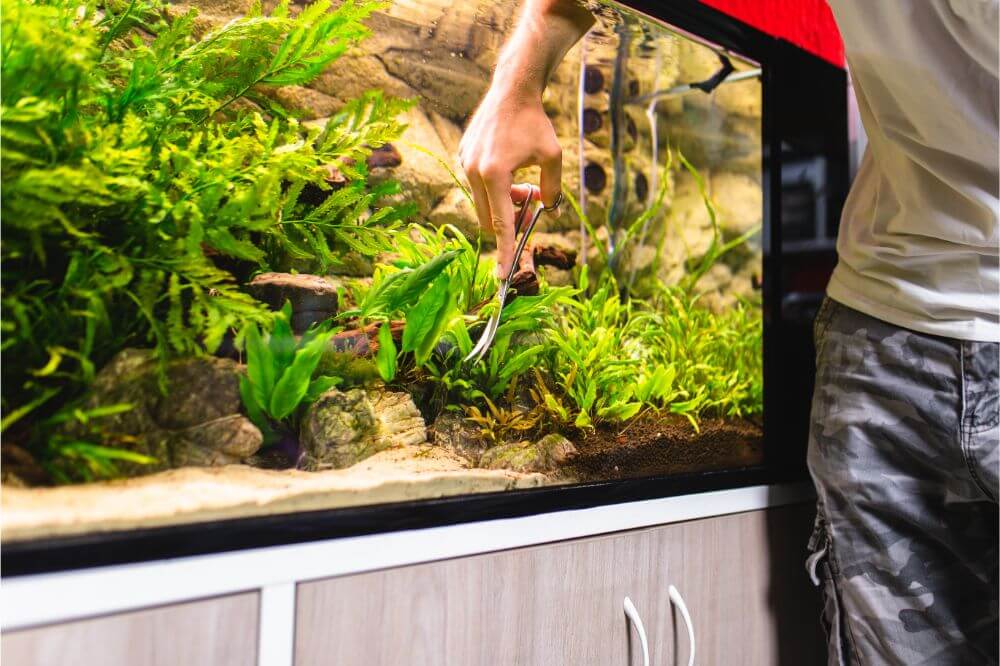How to Set Up a Fish Tank
How to Set Up a Fish Tank

Setting up a freshwater fish tank for the first time can be a daunting task. You need to set up the fish tank long before you are ready to add fish, so that you have a safe and healthy environment ready for them. Setting up a fish tank takes some time and thought, but your fish will thank you for it. Here’s everything you need to know on how to set up a fish tank.
How to Set Up a Fish Tank: Step-by-Step
Step One: Getting a New Aquarium and Equipment
Choosing a fish tank is more difficult than it looks. Generally speaking, bigger is better for the health of your fish, but there are limits to how large a fish tank can be in a typical house. Some of the things to consider before choosing your fish tank are:
- Rules or regulations. Some rental homes don’t allow aquariums.
- Size and weight. A filled aquarium is heavy. A “small” 10 gallon fish tank weighs over 110 pounds. A fish tank needs to be placed on a completely level surface that is strong enough to bear the weight.
- Light and environment. A fish tank should never be placed in direct sunlight because it causes the temperature to change too dramatically too quickly. Place your aquarium in a space with ambient light, but not in a sunny window. Fish also usually don’t like bright, flashing lights, so it’s a good idea to keep your tank away from a television or other media devices.
- Ease of access. To clean and maintain your aquarium, you will need to regularly add and remove large amounts of water. It can be convenient to have your fish tank near a sink, hose, or drain because it reduces your need to carry heavy buckets of water. Your fish tank will also need to be near a robust electrical outlet to power lights, filters, heaters, and other equipment.
Once you’ve considered all these factors, you are ready to buy your fish tank! You will need:
- A fish tank
- An aquarium heater
- A water filter
- Water treatment and conditioning products
- An aquarium water test kit
- Fish food
- Gravel or substrate
- Plants, décor, and other decorative additions
Step Two: Setting Up Your Fish Tank and Water
Here are the steps to follow to set up your new freshwater fish tank for the first time:
- Fill one or more large buckets with tap water, add water conditioner, and set them aside to reach room temperature
- Rinse out your fish tank and lid. Using hot water only, without soaps or detergents, rinse off the fish tank and accessories.
- Rinse off your plants, décor, and gravel. Again, simply use hot water to rinse off your tank décor to remove dust and debris. It is usually helpful to use a strainer or colander when rinsing gravel or substrate. For fine substrate like sand, consider using cheesecloth.
- Place your fish tank. Place the fish tank where you intend to keep it, checking once more to make sure that all your cords and cables reach the tank. Add your gravel or substrate.
- Fill the tank with water. Fill the fish tank with the prepared water.
- Turn on your water filter and your aquarium heater
Step Three: Cycle Your Fish Tank
“Cycling” your tank refers to starting a healthy balance of bacteria that will naturally reduce the amount of harmful ammonia and nitrites that fish produce with their waste. The right bacteria balance will convert your fish’s waste into nitrites, then into harmless nitrates, which are naturally removed with water changes.
Cycling a new fish tank can take a long time because you need to create a good environment for beneficial bacteria and then wait for them to grow. Until your nitrogen cycle is well-established, it’s not a healthy environment for fish. So, it’s best to cycle your tank and make sure the water is safe and balanced before you add any fish.
You can speed up the cycling process by using bacteria from an established fish tank, rather than starting from scratch with your own.
If you know someone who has a healthy fish tank with a similar water chemistry to yours, you can ask them for some of their used aquarium gravel or filter media and add it to your own tank. You can also buy aquarium bacteria starter products.
To cycle a new fish tank using a starter from another tank or with a bacteria starter product:
- Ensure that the purchased product or the borrowed gravel or filter media is fresh and used quickly, so the bacteria remain living and healthy.
- Place the product or starter in your tank, and add one small fish per 10 gallons of water
- Every other day, test the water and feed the fish. Over time, you should see a rise in ammonia, followed by a rise in nitrites, followed by a rise in nitrates, over the course of the next 7-14 days. If ammonia reaches dangerous levels, perform a small water change to protect your fish.
- When most of the ammonia and nitrites have been converted to nitrates, perform a large, 50-70% water change.
To cycle a new fish tank without seeding it with existing bacteria:
- Purchase aquarium-grade ammonia.
- Add enough drops of ammonia to reach 5ppm.
- Every 2-3 days, test your aquarium water and add ammonia to reach 5ppm.
- Over the course of 9-12 days, you should see ammonia levels rise, and then nitrite levels appear in your test.
- Once you see nitrites, continue to test every 2-3 days, and add ammonia to reach 2-3ppm.
- Over the course of the following 14-20 days, you should start to see nitrate levels appear in your test.
- Once you see nitrates, test every day, adding ammonia to reach 1-2 ppm.
- Over the next few days, you should see both ammonia and nitrite levels reach 0, with only nitrates remaining.
- Perform a large, 50-70% water change.
Step Four: Consider a Quarantine Tank
If you have a healthy fish tank and healthy fish, the best way to protect your fish and make sure your tank stays healthy is to set up a “quarantine tank” for new fish.
Quarantining is less important if you buy all your fish from the same local store, since all the fish are likely to have been exposed to the same microbial environment.
Quarantining is critical if you are buying fish from a wide range of sources and dealers, or are ordering fish online. Having a separate tank to quarantine new fish is a great idea because it does several important things:
- Allows new fish to gradually become accustomed to your water and their new life in your home
- You can observe new fish closely for any sign of health problems before you add them to your tank, where they may infect other fish
- Allows you to treat and medicate any health conditions in new fish without needing to unnecessarily affect the rest of your aquarium ecosystem
- Once you have a fully stocked aquarium, and aren’t planning on adding new fish, you may convert the quarantine tank into a breeding tank and explore a whole new dimension in fish keeping.
Once you’ve set up your primary fish tank, adding a smaller quarantine tank is a snap. Here is what you need:
- A small fish tank. If you will be quarantining small schooling fish, a 5-gallon tank is fine. For larger exotic fish that produce more waste, like fancy goldfish or angelfish, consider a larger 15-gallon tank to save you time in cleaning and water changes.
- A small heater and filter.
- Transfer some filter media from your established tank to the quarantine tank to start the nitrogen cycle. Remember that if you allow the tank to stay empty, without fish or manually added ammonia, these bacteria will die. So, it’s best to transfer filter media just before actually putting a fish in the quarantine tank.
- Fill the quarantine tank half with fresh conditioned water, and half with water from your established tank, so that it has the same water chemistry as your primary fish tank.
- You will also need some fish-care items that are used exclusively in the quarantine tank. A fish net, for example, that is used on a new fish in quarantine should never be used in your established tank. Keep an entirely separate bucket for water changes, scrubbers and scrapers, and other fishkeeping materials.
- You may also need some basic fish medicines like aquarium salts or anti-parasite treatments.
Quarantine tanks should have minimal decorations so that you can easily observe the fish, but enough decorations to not stress the fish. Choose easily disinfected items like plastic plants and PVC tubes that won’t harbor parasites.
To quarantine a new fish
- Allow the fish to acclimate to the water temperature as normal
- Put the fish in the quarantine tank
- Feed it as normal, and observe the fish for 2-4 weeks
- If the fish appears normal and healthy, and doesn’t display any signs or symptoms, you can place it into your established aquarium.
- If the fish shows signs of illness or disease, treat appropriately while in the quarantine tank
- Sterilize the quarantine tank and tank equipment with a 5-10% bleach solution between uses.
Step Five: Stock Up Your Fish Tank!
When establishing a new tank, it’s important to not add a whole population of expensive fish right away. Instead, add just a few fish at a time, in order to keep your nitrogen cycle in balance, and continue to test the water to make sure it is safe and healthy.
Quarantining fish helps protect your aquarium environment and prevents problems before they start. It’s also a great way to pace out the rate at which you fill your primary tank.
Setting up a fish tank can take some time and effort, but doing it properly from the beginning is worth it. The right set up keeps your fish happy and healthy. It reduces effort and maintenance when cleaning and caring for the tank. Your fish will thank you for it.


